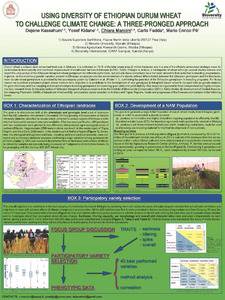Using diversity of Ethiopian durum wheat to challenge climate change: a three pronged approach
Current climate change projection models show that both temperature and precipitation are expected to increase in the Horn of Africa, and that climate uncertainty and frequency of extreme events will most likely increase the vulnerability of the rural poor in the region, Ethiopia included. Genetic diversity in crops represents a crucial resource for adapting local farmers’ systems to climate change. Durum wheat (Triticum turgidum spp. durum) is one of the officially announced strategic crops for contributing to food security and livelihood improvement of smallholder farmers in Ethiopia. To address this issue we developed a three-pronged approach aimed at the characterization and exploitation of Ethiopian tetraploid wheat germplasm to tackle the challenges posed by climate change: 1. Germplasm Characterization (molecular and morphological) of 400 landraces of durum wheat, 2. Development of nested association mapping (NAM) population of a sub-set of 50 accessions for discovery of genes useful to adapt to climate change and 3. Participatory Selection of all accessions by male and female farmers. This poster was presented at the International symposium on genetics and breeding of durum wheat from 27-30 May, 2013, Rome. (http://dwis.accademiaxl.it/index.php)

